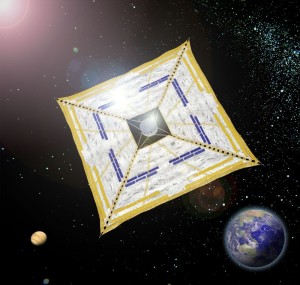Japan Sets Sail for Venus
While the U.S. space program is mired in political arguments over how to reach Earth orbit (something we’ve known how to do for 50 years), Japan’s space agency JAXA, with far less money, is about to take a small but noteworthy step into the future.An HII-A launcher is scheduled to lift off from the…

While the U.S. space program is mired in political arguments over how to reach Earth orbit (something we've known how to do for 50 years), Japan's space agency JAXA, with far less money, is about to take a small but noteworthy step into the future.
An HII-A launcher is scheduled to lift off from the Tanegashima Space Center early on the morning of May 21, Japan time (Note: Launch postponed from May 18), with two spacecraft on board: a Venus orbiter called Akatsuki, and a smaller craft called IKAROS (Interplanetary Kite-craft Accelerated by Radiation Of the Sun). With all due respect to Venus researchers, it's the second payload that really interests me.
Solar sailing has long been suggested as a cheap, efficient way to cross vast stretches of space without having to carry whopping amounts of rocket fuel. Turn your sail into the sunlight, wait a while, and you'll start building up speed. No fuel required, just photon pressure.
Due to a series of launch mishaps, the technology has never advanced much beyond ground tests. Now IKAROS actually hopes to go somewhere. It will ride alongside Akatsuki to Venus, swing past the planet, then go into orbit around the sun.
Because this is a technology demo and not a science mission, the JAXA engineers will be halfway to happiness if the sail just deploys properly. The 65-foot-diagonal square sail is made of a material called polyimide, just 7.5 microns in diameter, not much thicker than spider silk. It will unfurl from a spinning spool (start watching the Japanese-language video below at about the 6:50 mark to see the deployment). Tip weights at the corners provide tension—the sail has no frame.
The other key technology IKAROS is meant to demonstrate is power generation. About 5 percent of the sail's surface is covered with thin-film solar cells, which will produce electricity. JAXA intends to follow the IKAROS demo later this decade by sending a larger (165-foot diagonal) sail to Jupiter and the Trojan asteroids, which will require additional thrust from ion drive—powered by the solar cells fixed to the sail.
It sounds ambitious, but the Japanese have been working on solar sail technology for years, and according to IKAROS project head Osamu Mori, this time they think they have a winning design, particularly when it comes to the material.
The idea for a solar sail first appeared about 100 years ago. Since then, there has been a lot of research done on this in western countries as well as Japan, but so far no one has made a breakthrough. One of the reasons for this is that the technology didn't exist to reliably produce a lightweight thin film for the sail, which is very important. This film has to be made from a material that's not just lightweight but can withstand extreme radiation and heat in space. The material that meets these conditions is polyimide resin, which is used as a foam insulation for satellites. Once such a high-quality material became available, the development of a solar sail came much closer to reality. Today, Japan has the largest market share in the world for polyimide resin. We are currently leading the race to develop applications for this technology, and it would mean a great deal to us to be the first in the world to build a working solar sail.If all goes well, IKAROS will unfurl its wispy membrane about a month after launch, then set sail for Venus.
Ya gotta be rooting for this one.